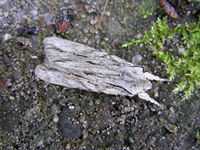Lithophane leautieri
| Lithophane leautieri | |
|---|---|
 | |
| Scientific classification | |
| Kingdom: | Animalia |
| Phylum: | Arthropoda |
| Class: | Insecta |
| Order: | Lepidoptera |
| Family: | Noctuidae |
| Genus: | Lithophane |
| Species: | L. leautieri |
| Binomial name | |
| Lithophane leautieri Boisduval, 1829 | |
The Blair's Shoulder-knot (Lithophane leautieri) is a moth of the Noctuidae family. It is found in Europe. It originated from the area surrounding the Mediterranean Sea, but gradually moved north.
Technical Description and variation
- See glossary for terms used
The wingspan is 39–44 mm.Forewing pale grey, dusted with olive grey; lines strongly dentate, but much obscured, marked by short oblique costal streaks; upper stigmata ill-defined, but united at their base by a long black line; the reniform with fulvous in lower half; claviform elongate, black-edged,united by a short black streak with outer line; a well-marked black streak from base on submedian fold;submarginal line indicated only by black dentate marks preceding it, of which the two on the folds are longest; fringe mottled dark and light grey; hindwing pale brownish grey, darker towards termen; ab. sabinae Geyer is rather smaller, blue-grey, more distinctly marked, especially the median shade and submarginal teeth; reniform stigma with hardly any fulvous in it; the two black lines on submedian fold hardly visible.[1]
Biology
The moth flies from September to mid November.
Larva dark green, dorsal and subdorsal lines white, segmentally swollen and partially interrupted; spiracular line yellowish white.The larvae feed on various cypress species.[2]
Notes
- ^ The flight season refers to Belgium and The Netherlands. This may vary in other parts of the range.
References
- ↑ Seitz, A. Ed., 1914 Die Großschmetterlinge der Erde, Verlag Alfred Kernen, Stuttgart Band 3: Abt. 1, Die Großschmetterlinge des palaearktischen Faunengebietes, Die palaearktischen eulenartigen Nachtfalter, 1914
- ↑ "Robinson, G. S., P. R. Ackery, I. J. Kitching, G. W. Beccaloni & L. M. Hernández, 2010. HOSTS - A Database of the World's Lepidopteran Hostplants. Natural History Museum, London.".
External links
- Lepiforum
- Funet Taxonomy
- Fauna Europaea
- waarneming.nl (Dutch)
- Vlindernet (Dutch)
- Phegea: new species in Belgium (Dutch)
- Blair's Shoulder-knot at UKmoths